Beneficials in the orchard
Several functional groups of organisms are essential and benign for the fruit grower. The pollinators are necessary to guarantee proper fruit setting. And the natural enemies of fruit pests – so called biological control agents – help to prevent pest outbreaks and heavy fruit loss. As often in life it’s the inconspicuous ones which are the most effective… those belonging to the huge kingdom of the invertebrates, especially the insects and spiders. But the bigger predatory birds and mammals contribute inevitably to the limitation of pest densities too and their presence as well as their nesting and breeding in the orchard shall be encouraged. On the other hand, soil life is represented by tiny organisms of various and diverse life forms and ecological roles and responsible for fertile soils promoting plant growth.
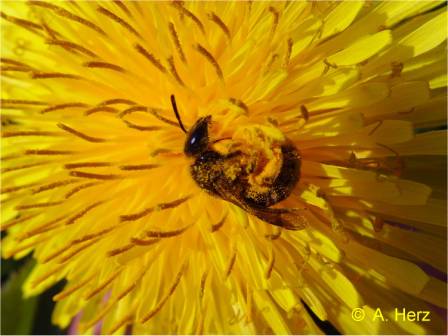 |  |  |
Wild bees Successful pollination is the basic process in proper fruit production. Nearly all fruit trees require cross-pollination which is mainly done by bees and other flower-visiting insects. Especially mason bees (Osmia-species) love to visit apple flowers in early spring even at bad weather conditions, and are most efficient pollinators. Other wild bees are valuable indicators of the general status of biodiversity and quality of life in your orchard. They need flowers all around the season, sufficient nesting sites and an environment with minimal pesticide use. More info needed? – click here | Ladybird beetles A well known beneficial is the 7spot ladybird and nowadays also the harlequine ladybird which originally comes from Asia. But more than 200 other species of these voracious predators occur in Europe and help to reduce the big mass of aphids and other plant suckers which may threaten healthy development of fruit trees. Both larvae and beetles can consume several hundreds of aphids and may erase colonies of the rosy apple aphid in very short time. They also feed other insects and need plant derived food, especially pollen, nectar and plant sap before winter. More info needed? – click here | Predatory bugs There are several “bad bugs” known in your orchard which damage the fruit – but the flower bugs or “pirate bugs” (Anthocoridae) are really good ones! Both adult and larvae feed on various soft-bodied smaller prey and also on the eggs of many fruit moth pests. They can survive on pollen and other plant material too, therefore the provision of the habitat with flowering plants can sustain bigger populations of these beneficial biological control agents. |
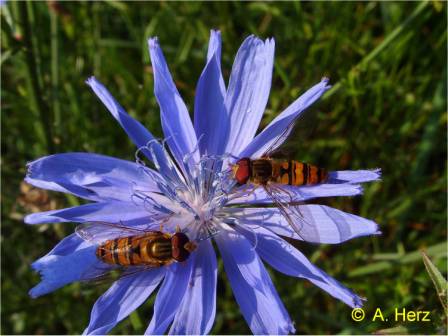 | 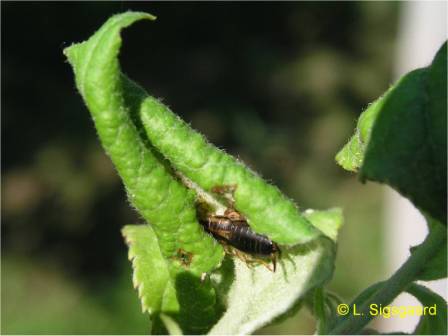 | 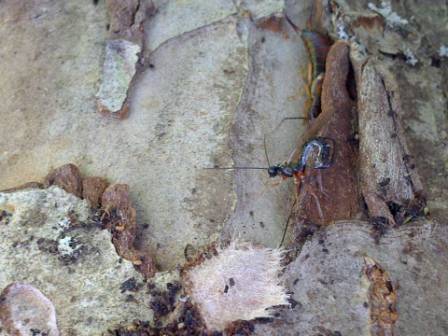 |
Hoverflies Several hundreds of hoverfly species (Syrphidae) exist in Europe and show various life histories. About one third is known to be aphidophagous which means that the larvae feed on aphids and other small leaf-dwelling insects. All adult hoverflies require pollen for being fertile and a continuous supply of nectar for being able to fly. Therefore they belong to the frequent flower visitors. Some of them are even important as pollinators like the dronefly, Eristalis tenax. The slug-like larvae of aphidophagous species are difficult to recognize because they often look like bird droppings near aphid colonies and also hide during day. More info needed? – click here | Earwigs These are the all-rounders in the orchard. Due to their very broad diet range, earwigs are important predators of many smaller organisms. They also eat plant-derived food and sometimes can damage soft fruits. But their activity is mainly beneficial for the fruit grower, for instance being an efficient antagonist of the woolly apple aphid. Earwigs establish well in older orchards with many ecological infrastructures. Being crepuscular, they like suitable hideouts to pass the day at a safe place. | Parasitoids – wasps & others So-called parasitoids live in their larval stage on one host (like a parasite), but kill this host inevitably at the end (like a predator). Parasitoids are very specialized natural enemies, because they live in extreme intimacy with their particular host. Many wasp families have developed this life style – the consequence is a huge diversity of several thousands of species – also in your orchard! Due to the never-ending co-evolutionary arms race, parasitoids have developed very sophisticated – and efficient! - strategies to locate, parasitize and kill their host. |
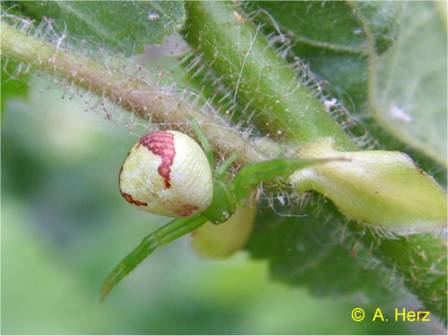 | 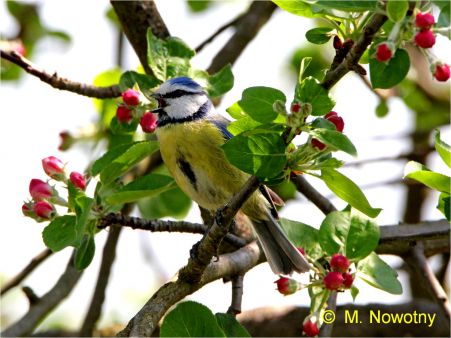 | |
Spiders and relatives Spiders and their relatives range in size from a few mms to several impressing cms including their long legs. True spiders are predators which exhibit various hunting behaviours: jumping hunters, sit & wait ones and of course the web builders offering a deadly barrier for many arthropods on the wing. The tiny predatory mites are very efficient natural enemies of spider mites and the natural control of the European red mite Panonychus ulmi in apple orchards relies on them. | Birds Insectivorous birds can be very effective predators of many orchard pests. Especially during breeding season, they collect protein-rich food for their progeny, for instance caterpillars of the winter moth in early spring, leaf-rollers, aphids and adult stages of various pest insects. Birds profit from suitable nesting sites. Installing nesting boxes let them stay in the orchard and near the apple producing fruit trees for foraging prey. Raptors are important to keep low densities of voles. |
All necessary resources should be available to preserve and enhance the activities of these creatures in the orchard. Plant diversity plays here a decisive role maintaining these fundamental ecosystem functions.

